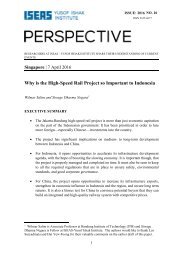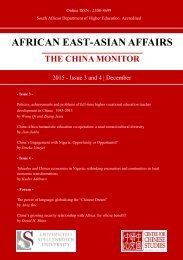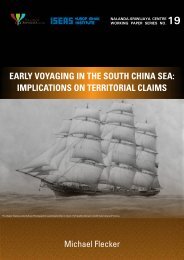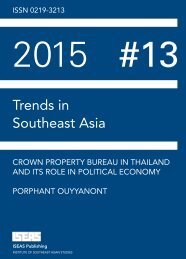Create successful ePaper yourself
Turn your PDF publications into a flip-book with our unique Google optimized e-Paper software.
INTRODUCTION<br />
Much research h<strong>as</strong> been conducted on <strong>the</strong> history of <strong>the</strong> <strong>Malayan</strong> <strong>Communist</strong> <strong>Party</strong> (MCP). Prior to<br />
<strong>the</strong> Hadyai Peace Agreements that were signed <strong>in</strong> 1989 between <strong>the</strong> Government of Malaysia and<br />
<strong>the</strong> MCP and between <strong>the</strong> Government of Thailand and <strong>the</strong> MCP, research on <strong>the</strong> party ma<strong>in</strong>ly<br />
depended on government sources, that is, official documents and files belong<strong>in</strong>g to <strong>the</strong> British<br />
colonial authorities and <strong>the</strong> <strong>Malayan</strong>/Malaysian government. After <strong>the</strong> Hadyai Peace Agreements,<br />
various MCP sources of <strong>in</strong>formation also became available to researchers and, about <strong>the</strong> same time,<br />
a few dozen former MCP members began to publish not only <strong>the</strong>ir memoirs but also historical<br />
party documents. <strong>The</strong> new materials have tremendously enriched <strong>the</strong> historiography of <strong>the</strong> MCP.<br />
From <strong>the</strong>ir very beg<strong>in</strong>n<strong>in</strong>g, communist organizations of Malaya, <strong>in</strong>ter alia, <strong>the</strong> MCP, were guided<br />
and led by <strong>the</strong> <strong>Communist</strong> International (Com<strong>in</strong>tern) which w<strong>as</strong> established <strong>in</strong> March 1919 and<br />
dissolved <strong>in</strong> May 1943. Ow<strong>in</strong>g to difficulties <strong>in</strong> ga<strong>in</strong><strong>in</strong>g access to <strong>the</strong> archives of <strong>the</strong> Soviet Union<br />
(USSR), <strong>the</strong> Com<strong>in</strong>tern files kept <strong>in</strong> Moscow could not be consulted for a long time. After <strong>the</strong><br />
collapse of <strong>the</strong> USSR, however, its archives were opened to foreign historians. In <strong>the</strong> p<strong>as</strong>t decade, a<br />
few scholars, such <strong>as</strong> Sophie Qu<strong>in</strong>n-Judge, 1 Kurihara Hirohide 2 and Larisa Efimova 3 have used<br />
Com<strong>in</strong>tern files <strong>in</strong> research that made references to <strong>the</strong> MCP. For <strong>the</strong>se scholars, however, <strong>the</strong><br />
MCP constituted a ra<strong>the</strong>r m<strong>in</strong>or portion of <strong>the</strong>ir work and <strong>the</strong>y only used a small part of <strong>the</strong><br />
available material. Thus, historical studies of <strong>the</strong> MCP that consistently and comprehensively use<br />
<strong>the</strong> Com<strong>in</strong>tern files have not been carried out yet.<br />
For its part, <strong>the</strong> present work uses Com<strong>in</strong>tern documents mentioned <strong>in</strong> <strong>the</strong> Preface to revisit <strong>the</strong><br />
early history of <strong>the</strong> MCP that rema<strong>in</strong>s an important area of <strong>in</strong>quiry because <strong>the</strong>re are differ<strong>in</strong>g<br />
<strong>the</strong>ories and viewpo<strong>in</strong>ts regard<strong>in</strong>g several b<strong>as</strong>ic issues, <strong>as</strong> discussed below.<br />
<strong>The</strong> MCP’s Antecedent and Establishment<br />
Prior to <strong>the</strong> MCP, a communist organization w<strong>as</strong> formed that covered communist activities <strong>in</strong> <strong>the</strong><br />
whole of Sou<strong>the</strong><strong>as</strong>t Asia (<strong>the</strong> “South Se<strong>as</strong>” or Nanyang). For some time, it w<strong>as</strong> commonly held that<br />
<strong>the</strong> antecedent of <strong>the</strong> MCP w<strong>as</strong> formed <strong>in</strong> 1928 <strong>as</strong> <strong>the</strong> Nanyang <strong>Communist</strong> <strong>Party</strong> (NCP). Professor<br />
C. F. Yong (hereafter occ<strong>as</strong>ionally Yong), however, argued that this “established <strong>the</strong>ory” w<strong>as</strong><br />
flawed. Mostly from his <strong>in</strong>terviews with former <strong>Malayan</strong> communists who had settled <strong>in</strong> Ch<strong>in</strong>a<br />
after be<strong>in</strong>g deported from Malaya or had left Malaya on <strong>the</strong>ir own accord <strong>in</strong> <strong>the</strong> 1930s and 1940s,<br />
6








